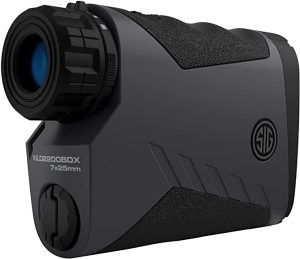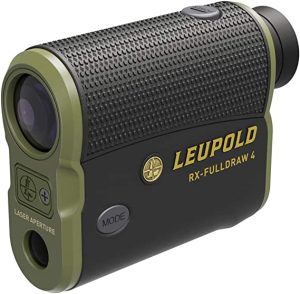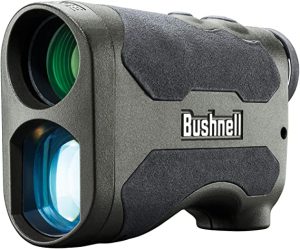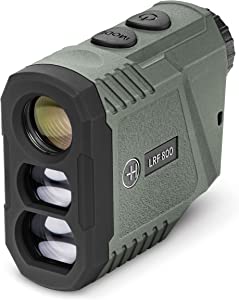5 best Bow/Rifle Hunting Rangefinders for the Money
Laser rangefinders are getting better and better, with features like arrow flight ballistics and vibration dampening to help archers shoot more accurately.
Bow hunting is a close-quarters game, which might make you think it’s less important to know the exact yardage to your target than in precision-rifle competitions, where shooters often hit targets up to 1,200 yards away. However, rangefinders are essential in both sports.
A rangefinder typically consists of a laser and a viewing monocular. Imagine that a bullet is fired from a gun, travels to its intended target, and then returns to the gun after being deflected. Your rangefinder’s laser functions a lot like a bullet. When you click the button on your rangefinder, it sends a laser beam to the target, which then comes back to the rangefinder to tell you how far away it is.
When using a rifle or a bow, carrying a rangefinder lets you get rid of any confusion about distance.
Knowing the precise distance to the target will give you more confidence to take the shot or the knowledge that it is too far away to take a chance.
These days, rangefinders are much more versatile. With the angle of the shot taken into consideration, a sophisticated rangefinder will give you ballistic information as well as the appropriate distance for your shot.
Bow/Rifle Hunting Rangefinder Buying Tips
First, are you actually in need of a rangefinder designed specifically for bow or rifle hunting? Many models that are suitable for rifle shooting are also completely compatible with bow hunting. Ensure that the least distance is approximately 10 yards and that angle-compensating modes and line-of-sight ranges are included. The following are additional factors to take into account before purchasing a rangefinder:
- Single-handed
How easy is it to use the rangefinder with one hand, assuming that your other hand will be holding your bow?
- Arrow Flightpath Technology
Does the device have a program that can figure out the trajectory of your arrow? You will be able to fire over or under limbs as well as other obstacles with the assistance of this function.
- Accuracy
The most accurate rangefinders designed specifically for archery provide readings in fractions of yards.
- Add-ons
An excellent rangefinder for bowhunting should also include the following properties in addition to angle compensation: rapid ranging, waterproofing, and outstanding low-light performance. Most opportunities for archery shots arise in the early and last thirty minutes of shooting light.
Our Recommendations….
| Award | Design | Outdoor | Retailer |
|---|---|---|---|
| Perfect | Best Pick  | Check Price | |
| Outstanding | Staff Pick  | Check Price | |
| Superb |  | Check Price | |
| Excellent | Budget Pick  | Check Price | |
| Best |  | Check Price |
Vortex Optics Razor HD 4000 Laser Rangefinder

The Vortex Optics Razor HD 4000 laser rangefinder offers the maximum features at the lowest possible price. It’s the best choice for golfers, bowhunters, and people who shoot at long distances.
This laser rangefinder from Vortex is covered by a lifetime warranty, which is one of its best features. No worries if you decide to sell it again in the future. Additionally, this device can operate reliably for so many years without difficulty. With a maximum range of 4,000 yards in ELR mode, the Vortex Optics long-range hunting rangefinder is capable of long-distance hunting.
Ultra-bright transmission is made possible by the HD Optic system and XR Plus Fully Multi-Coated that are included with this gadget. It provides a clearer image and is even sharper than the Vortex 1800 model, but keep in mind that it is not a Leica product.
With five brightness levels, the red-illuminated display is easily adjustable. When adjusted to the lowest setting, it is simple to read in low-light situations. The reading time is also quite effective because it can range objects at 2,000 yards in just 0.25 seconds!
If you shoot at a distance less than 200 yards away, the laser rangefinder made by Vortex Optics is incredibly precise, with a degree of precision that is within a yard or two. Maximum angle measurement of up to 70 degrees is available in the HCD (Horizontal Component Distance) mode of angle compensation.
For rifle shooters, these statistics are reliable and sometimes even required, especially when using ballistic estimations to adjust for bullet drop and windage. For archers, it enables sight pin adjustments. They work well for shooting on uneven terrain.
In comparison to the other versions on this list, the Vortex Optics range finder is fairly heavy. Because it is comprised of magnesium, it weighs 9.9 lbs. With only 4.5 inches in length, this device is fairly little in terms of size.
So it’s comfortable to hold and easy to load into a hunting backpack. A tripod or shooting rest can be quickly and easily attached to the rangefinder. The device is weatherproof, so it can endure snow, rain, and dust.
Pros
- Lifetime Guarantee
- Long Range
- Outstanding Optics
- illuminated red display
- Robust
- Precise
- Angle Correction
- Excellent quality and design
- An intuitive and simple-to-use menu
Cons
- Long-distance shooting necessitates the use of a tripod.
- There is no Bluetooth connection.
- The reticle is diminutive and lacks a central dot.
Sig Sauer Kilo 2200 BDX

When it comes to shooting at long ranges, the Sig Sauer Kilo 2200 BDX is the model of choice. Although it was initially created for long-range hunters, you can also use it for golf.
The software is simple to configure and can provide precise ballistic statistics for long shots, including elevation, windage, angle, range, etc.
It exchanges real-time data with a BDX rifle scope and performs extraordinarily well with it.
The brightness of the optics can be automatically adjusted to match the conditions of the surrounding area. However, you can also manually alter it to suit your tastes.
Due to the presence of three red reticles, it is simple to determine the distance in low light or highly bright settings.
Most devices in this price range have a magnification of 6x, but this one has a magnification of 7x.
The device claims to have a 3,400-yard total range capacity, but you can anticipate that your precise measurements will be 2,200 yards for elk and 1,300 yards for deer.
If you are standing on the ground blind, the rangefinder can even measure distances through the blind mesh.
The readout happens quite quickly, providing you with an exact and immediate shooting range.
It even includes a scan mode that is as fast as lightning. It updates four times per second to keep up with moving objects like deer or elk.
If you’re going to be hunting from the treetop, you’ll need ARM mode, which automatically adjusts the angle.
The gadget is also reasonably lightweight and waterproof. It only weighs 7.5 ounces because the case is made of magnesium.
With this ranger, the electronic components are covered by a 5-year guarantee, and the rest is covered for life.
With only two buttons, it is quite simple to use.
Pros
- It is compatible with the Sig BDX mobile application.
- High-quality lenses
- Outstanding for shooting at long range.
- Auto angle correction
- Water-resistant
- Water-resistant
- Intuitive interface
Cons
- No archery mode
- It is incompatible with devices made by Kestrel.
- There is no tripod holder.
Leupold RX-FullDraw 4

When shooting from an incline, angle adjustment is of critical importance. Consider purchasing a Leupold RX FullDraw 4 if you shoot arrows and are in the market for a new rangefinder.
It is designed to be used by hunters who use bows and rifles.
This model’s ability to calculate distance within half a yard immediately appealed to me.
In order to provide an exceptionally accurate range, Archer’s Advantage software requires the input of data from the user. These factors include things like velocity, arrow weight, and peep height.
As a result, it is ideal for Western hunters and 3D archers.
If you’re trying to determine the range of something, the arrow’s route will appear as a line above the reticle.
It has the potential to prevent you from striking with a little twig or bush, or even missing an animal entirely. It’s great for confined spaces.
These optics are top-notch, offering a magnification of 6x and a transparent multi-coating on all surfaces.
You can immediately range the target using the red reticle’s OLED display, which is simple to read even in poor light.
The device is easy to use because it only has a few modes and a few buttons.
This is a really sturdy and long-lasting piece of equipment, so you shouldn’t have to worry about replacing it for at least a couple of years. The rubber coating also makes the device feel comfortable in your hands.
This model is completely waterproof and fog proof, as well as adaptable.
With its small size and light weight of 7.5 ounces, it may easily fit in your purse or binocular harness.
Pros
- Technology-based on the angle-compensating ARC
- Scanning method that is quick and accurate
- Ergonomic design
Cons
- There is no connectivity with the ballistics app.
- 500-yard maximum range for targets
Bushnell Broadhead

This Bushnell laser rangefinder is equipped with three features that make it an indispensable tool for archery deer hunters. The first and most significant feature is Angle Range Compensation (ARC) technology, which has been tuned specifically for hunters that post up in the top tree stands. The Broadhead has the highest level of precision in its class, measuring with a 0.3-yard sensitivity out to 150 yards. When you combine the light-sensitive reticle with the scanning mode, which enables hunters to track targets despite the presence of distracting branches, you get a rangefinder that is suitable for use by mid-distance hunters in a diverse set of environmental conditions. In addition, the 8x magnification makes this one of the most potent monoculars on the market.
Pros
- Technology-based on the angle-compensating ARC
- scanning method that is quick and accurate
- Ergonomic design
Cons
- There is no connectivity with the ballistics app.
- 500-yard maximum range for targets
Hawke LRF800

The LRF800 will serve you well if you’re a hunter searching for a simple rangefinder that won’t break the budget. The 6×21 monocular can cover most hunting conditions with a range of six to 800 yards. Although its absence of angle-compensating capability prevents it from being used in many steep-country situations, its 4.6-ounce weight makes it perfect for backcountry hunts. Hawke LRF800 has the majority of the settings and functions you would expect in an archery rangefinder.
Pros
- Magnification of 6x
- Multiple-Coated optics
- A trio of target modes
- Lanyard and carrying case
- Black LCD screen
- 7 yards or less is the minimum distance
Cons
- The glass has a relatively dull appearance
- Brittle texture
Summary…
| Award | Design | Outdoor | Retailer |
|---|---|---|---|
| Perfect | Best Pick  | Check Price | |
| Outstanding | Staff Pick  | Check Price | |
| Superb |  | Check Price | |
| Excellent | Budget Pick  | Check Price | |
| Best |  | Check Price |
Frequently Asked Questions
What should I look for when buying a rangefinder?
High-end rangefinders have magnification that can reach 6x. It will appear that you are closer to the target the higher the magnification. The majority of rangefinders that are worth their price will offer you a range that is well in excess of 1,000 yards and will tell you how far away the flag is when you get within approximately 450 yards of it.
Are all rangefinders the same?
Rangefinders come in a variety of sizes and capabilities; some can measure distances of less than 400 yards, while others can measure distances of up to a thousand yards. They are also distinct from one another in terms of the functions they perform.
Is there a difference between golf range finders and hunting range finders?
Golf rangefinders employ nearest or first target mode. This is the intrinsic function of the rangefinder that allows it to locate the closest item (often a pin) by disregarding distant objects such as bushes. In far target priority mode, a rangefinder is used for hunting.
Are expensive rangefinders worth it?
If you want to get better at your sport, investing in a laser rangefinder is absolutely worthwhile. There are rangefinders available for less than $100 that provide a dependable and accurate distance reading, and if you use them frequently, you will get your money’s worth out of rangefinder.
Conclusion
The search for the most effective rangefinder for hunting has proven to be quite difficult. The greatest hunting rangefinder, in my view, is the Vortex Optics Razors HD 4000.